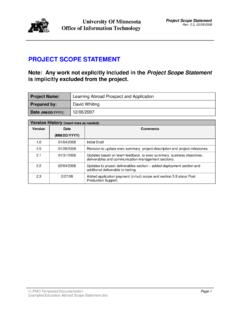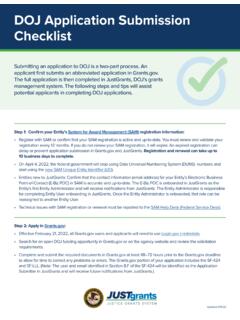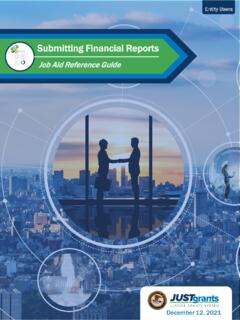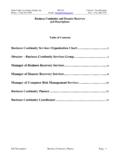Transcription of Unit 8 Project management
1 2016 Suite Cambridge TECHNICALS LEVEL 3. IT. Unit 8. Project management F/507/5008. Guided learning hours: 60. Version 2 - revised July 2016. *changes indicated by black vertical line Version 2: Issued July 2016 First teaching September 2016. LEVEL 3. UNIT 8: Project management F/507/5008. Guided learning hours: 60. Essential resources required for this unit: none This unit is internally assessed and externally moderated by OCR. UNIT AIM. This unit will provide you with the opportunity to understand and use various Project planning skills and techniques, thereby enabling you to become more effective in the workplace.
2 The key to any Project being a success is the planning that takes place. Project management skills are essential transferrable skills that can be used for all IT related projects whether it's traditional methodologies or more recently adapted agile approaches within the IT development environment. These skills can be adapted and used even on the smallest tasks' during the planning and implementation stages. Regardless of your job role, you will often be called upon to participate in projects for a variety of reasons; consequently this unit is optional within all four of the specialist pathways.
3 This unit will assist you in developing your skills, knowledge and understanding of different Project methodologies and the key factors that can influence the success or failure of a Project . Knowledge gained in the study of this unit will also help prepare you for relevant industry qualifications such as CompTIA Project +. Note: Learners must work on an IT Project that would reflect the type of Project carried out within the IT industry. For those learners following the Diploma qualifications their chosen Project will ideally reflect their chosen specialist pathway. OCR 2016 2 Unit 8: Project management Version 2: Issued July 2016 First teaching September 2016.
4 TEACHING CONTENT. The teaching content in every unit states what has to be taught to ensure that learners are able to access the highest grades. Anything which follows an details what must be taught as part of that area of content. Anything which follows an is illustrative, it should be noted that where is used, learners must know and be able to apply relevant examples in their work, although these do not need to be the same ones specified in the unit content. For internally assessed units you need to ensure that any assignments you create, or any modifications you make to an assignment, do not expect the learner to do more than they have been taught, but must enable them to access the full range of grades as described in the grading criteria.
5 Learning outcomes Teaching content The Learner will: Learners must be taught: 1. Understand the Project methodologies ( Prince2, waterfall, DMAIC. Project life cycle methodology, critical path method (CPM), agile development, individual methodologies as required by the client). Project life cycle, : initiation phase planning phase execution phase evaluation phase Project issues, : communication ( between team members, Project manager, stakeholders, clients). external factors ( finance, team members, etc.). conflicts ( between Project team members and/or client). lack of management /leadership poor planning legislation/regulation Documentation, : main documentation o Project brief/ Project mandate (overview of Project /scope/objectives).
6 O Project initiation document (PID)/ Project definitions document ( Project outline/scope/objectives). o contract (agreement from Project sponsor/budget holder to start Project ). o business case ( Project justification, cost versus benefits). o client acceptance form (to obtain agreement from Project sponsor/budget holder that Project is complete). o work breakdown structure o Project progress report (status updates while Project is in progress). o Project closure report (indication of outcomes). o lessons learned report (also survey). OCR 2016 3 Unit 8: Project management Version 2: Issued July 2016 First teaching September 2016.
7 Learning outcomes Teaching content The Learner will: Learners must be taught: main control registers and plans: o Project planner (visual aid to show the Project timelines and activities to be completed). o risk register (to record details of Project risks, monitoring and management of Project risks). o issues register (to record details of Project issues, monitoring and management of Project issues). o lessons learned register (to capture details of things when they go wrong to inform report at end of Project ). 2. Be able to initiate Initiation phase, : and plan projects stakeholders, clients, target audience scope definition purpose objectives resources ( fast tracking , crashing, delaying, optimising).
8 Tools ( Gantt charts, Network diagram (ADM, PDM, CPM,CCM)). deliverables timescales structure business case o several possible solutions o costs/benefits of each feasibility study (evaluation and analysis of a proposed Project ). terms of reference o accurate description of: what the Project aims to achieve criteria and flexibilities involved Project parameters, scope, range, outputs, sources, participants, budgets and timescales phase review Planning phase, : Project plan consisting of: o resource plan ( identification of staff, equipment and materials needed). o financial plan ( quantify the financial expenditure required).
9 O quality plan ( quality targets and quality control methods). o risk plan (identify risks and plan actions need to minimise risks). o acceptance plan ( specify criteria for accepting deliverables). o phase review OCR 2016 4 Unit 8: Project management Version 2: Issued July 2016 First teaching September 2016. Learning outcomes Teaching content The Learner will: Learners must be taught: is the Project under schedule and within budget? have the deliverables been produced and approved? have the risks been controlled and mitigated? have issues been resolved? is the Project on track?
10 Should the Project continue to the execution phase? 3. Be able to execute Execution phase, : projects time ( tracking and recording time spent on tasks as per Project plan). cost ( identifying and recording costs against budget plan quality ( review quality of deliverables and management process). change ( reviewing and implementing requests for changes to Project ). risk ( assessing level of Project risks and taking action to minimise the risks). issue ( identifying and resolving Project issues). communication ( communication with stakeholders, end users, clients, Project team members).)















